Salsa Vaya 1000 Mile Review (or our thoughts on Salsa Vaya vs. Surly LHT)
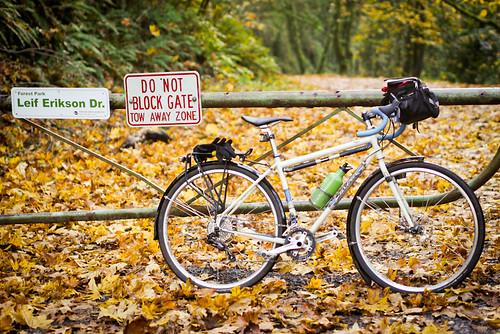
We’ve been riding our Salsa Vayas for a little over two months and have managed to put over 1000 miles on them. In that time, we’ve ridden them around town, on the 25th Anniversary Cycle Oregon ride, on our first randonneur event (the Verboort Populaire), up Larch Mountain, on a few overnight bike tours and miles and miles of hills and gravel on road rides around Portland. The good folks at VeloCult built up our frames with components that we picked out that are a little different from the off the shelf Vayas and we had the bikes fitted at Crank PDX. We’ve ridden them enough to get a good sense of how they handle and the ride qualities and what the best uses would be. So what’s the verdict? How do they compare to the venerable Surly LHT?
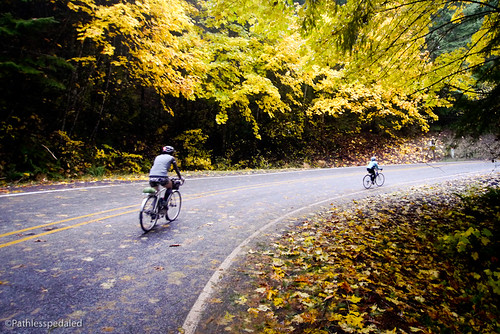
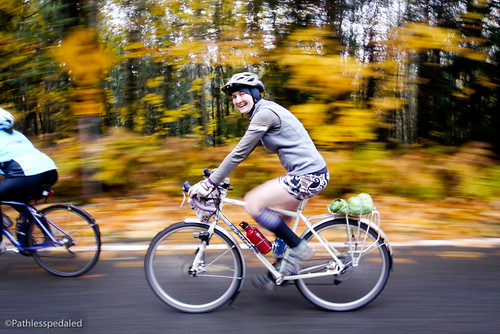
Mountain Doubles
Perhaps the biggest difference of our builds compared to the pre-built models are our choice of drivetrain. I’m using Apex brifters (which come stock on the Vaya 2) and Laura is using Shimano bar end shifters on some Paul Thumbies. Both work as advertised. The Apex brifters take a little more oomph to shift than Shimano counterparts, but I appreciate the cleaner cable routing and smaller hoods. Check out the video tour below to take a closer look at our handlebar controls.

In the beginning of our builds, we considered compact road doubles, but for us they seemed a little too highly geared for touring, so we decided to go with mountain doubles. Both of us are running identical drivetrains with SRAM X5 mountain double cranks with 42/28 chainrings, X7 front derailleurs, X9 rear derailleurs and 12-36 10speed cassettes. They work pretty seamlessly with both the Paul Thumbies and Apex brifters. Most people will ask, why a mountain double and not a touring triple? We rode with a touring triple on our LHTs for years and they worked fine. However, interestingly enough, after touring with the Bromptons (which only had 6 speeds), we knew we wanted to simplify our drivetrains from 27 speeds with lots of redundancy to just 20. Although we have a third fewer gears than a touring triple, our range is pretty similar. We’ve got a high gear of about 95 gear inches and a low of 21 gear inches. On a flat road we can spin up the pedals to about 25 mph (anything faster than that is beyond our ken of riding for this bike since we’ll most likely be loaded). The low of 21 gear inches has been low enough to get us up and over hills and mountains, even when carrying touring loads. If we were to go to truly mountainous terrain with an expedition load, we’d probably swap the small chainring for a 24t to drop us down to 18 gear inches.
The Frame
The Vaya has eyelets everywhere you would need them for touring. You get three bottle mounts in the inner triangle. The fork has mid-fork eyelets and two sets of eyelets at the dropout for a rack and fenders. Likewise, on the rear of the bike you have two sets of eyelets at the rear dropout for a rack and fender and eyelets at the seat stay for a rack. Our Vayas have the standard vertical dropouts and not the Alternator dropouts, so we were able to use rear racks off our previous bikes.
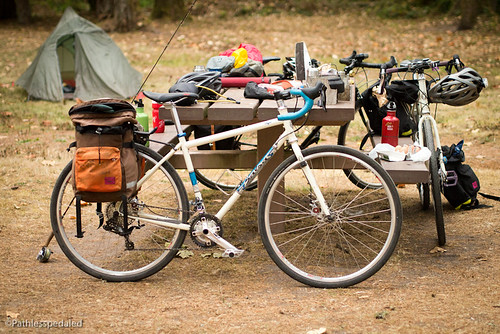

Perhaps the most noticeable frame difference is the sloping top tube on the Vaya compared to the LHT. There are lots of schools of thought about what is better. Some say bikes with sloping top tubes are lighter because of less material, stiffer because the triangle is smaller, etc., Being somewhat of a retro-grouch on occasion, it took me a little while to warm up to the looks of the sloping top tube. I’m not going to pretend to have Princess and the Pea heightened sensitivity for all frame nuances, but I will say that I have appreciated the extra clearance especially going on mixed terrain rides with steep slippy climbs. The sloping top tube gave a little more…em..fudge room when having to do a hasty footdown.
Disc Brake Converts
If you asked us a few years ago about what we thought of disc brakes, we would have told you “why bother when rim brakes are perfectly fine.” Having ridden the Vaya for the last few months, we’ve really come around to some of the advantages of disc brakes. We really appreciate the all-weather stopping capabilities (a must in Portland), not having to worry about overheating rims and blowing out tires on long descents and the dirt from brake pads getting everywhere. Of course, it’s not all roses. Disc brakes are a little less transparent than rim brakes, they squeal, and parts are varied and non-standardized. We feel that if you’re touring in super remote places or developing countries, rim brakes may still have an advantage. But, if you are touring in the US or a place where decent bike parts or the internet aren’t that hard to come by, then discs are perfectly fine.
The Ride
Our builds on the Vaya and LHT are different, so we can’t make an EXACT apples to apples comparison, but they are close enough to make some reasonable observations about ride quality. No doubt the LHTs are solid, stout and reliable touring bikes. Some could argue that it is because of the LHT that bicycle touring has made somewhat of a come back, with Surly bringing a great TRUE touring bike to market (not half ass attempts like the modern Trek 520). That said, after having ridden both frames for some time, we prefer the Vayas for the type of touring and riding we do now.
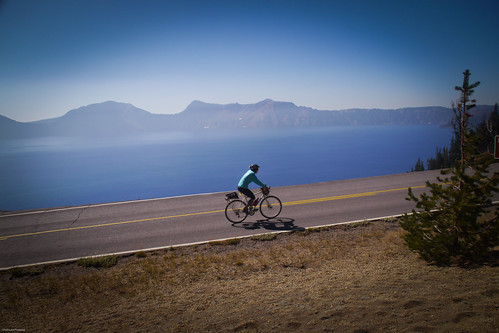

The Vaya is a fair bit more zippy and responsive than the LHT. It’s not roadie fast, but if you put the pedal to the metal, the Vaya will move without too much negotiation. Riding the first few weeks with the Vaya, Laura was constantly commenting how she felt like she could actually accelerate. The LHT, on the other hand, feels to have far more inertia to overcome. It will hold speed, but you have to work to get it up there.

One of our most memorable days riding the Vaya was on the final day of Cycle Oregon. It was 60 miles back to the town of Bly and we were both feeling pretty good. The last half of the ride was fairly flat so I tucked in and spun it up to about 25mph (loaded with camera gear, mind you) and was able to maintain that fairly well, even with the mountain double. Some roadies came up to us and said we were putting them to shame with our bikes with fat tires. 🙂 The Vaya is fun to ride both loaded and UNloaded. The riding is predictable, but it isn’t an utter snoozefest either. The LHT, on the otherhand, sometimes feels loaded even when it isn’t.

If it sounds like we are putting down the LHT, we’re not. We still believe they are the most bang for your buck touring bike on the market. If you’re planning to ride fully loaded, you won’t be disappointed. However, for us, we are starting to explore other types of riding. Longer randonneur events, mixed terrain riding, maybe even some gravel grinders are in our future and, for this style riding, with a much lighter load, the Vaya is a better fit. I feel that, of all the bikes on the market that I have had a chance to throw a leg over, the Vaya probably comes closest to being the perfect all-rounder bicycle – you can commute on the Vaya, tour with it, take it on gravel roads, long day rides and mult-day event rides and still have a smile on your face at the end of the day.
(UPDATED: I felt that I should address a comment to this post from Doug. We wholeheartedly agree that the LHT comes to its own under load. When we first toured, we had over 100lbs of gear on our LHTs and it faithfully portaged us around the country. There is no doubt that the LHT is capable of some heavy expedition style touring. Most of the touring we’ve done with the Vayas so far have been fairly short, so we haven’t quite put the same amount of stress on it as the LHT. Our feeling, however, is the Vaya is more suitable for light to mid weight type of touring. We would probably feel a little uneasy at loading the Vayas up with the same weight as we did with the LHTs. Thirty to forty pounds on the rear seems to be the sweet spot and it is nice to have some weight on the front for balance. We’re planning to do a few weeks of touring in January in California with the Vayas, which will have give a better sense of their handling for longer tours.)
Conclusion:
Our Surly LHT’s were definitely solid bikes and we built them up in a very traditional touring style. Bar-ends, friction shifters, touring triples, etc., But, we’ve changed from those early years of heavily-laden touring, and our view of cycling has expanded quite a bit as well. I still believe in the reliability of friction shifting, but I also know that having brifters on your bike won’t tear open a hole in the Space-Time continuum. I also know that although touring triples are sort of the de facto drivetrain choice according to Ye Old Touring Canon, it’s okay to explore different options that work for you (and do something crazy like put a mountain double on a road touring bike…or ride a 6spd folding bike). We’ve learned that, although you may have space for four panniers, two is often times enough and will allow you to more easily follow your curiosity without being burdened down by too much weight.
The Vaya is a fun bike. It’s fun with a load and without. It’s fun on the road and on mixed terrain. It’s fun to ride leisurely and to hammer. It is one of the most versatile bikes on the marketplace right now. If you want a bike that is capable of loaded touring, but also doesn’t feel like you’re dragging an anchor around when you’re not on tour, then the Vaya is for you.
Surly LHT
Pros:
-best bang for your buck out of all touring bikes on the market
-handles HEAVY loads extremely well
-true expedition style tourist
Cons:
-sluggish unloaded
Salsa Vaya
Pros:
-great at light/mid-weight touring
-FUN to ride unloaded
-great multi-use bike for commuting/event ride/touring
-disc brakes…woohoo
Cons:
-more spendy than LHT
-a little flexier at heavier loads
-disc brakes can squeal like crazy
Which one is for you?
If you tour with heavy loads – LHT.
If you tour with light to mid-weight loads – Vaya.
If your primary use is a fully loaded touring bike – LHT.
If you want a bike that can be also used for a variety of different styles of riding (commute, event rides, rando rides) – Vaya.
(Keep our adventures going and the site growing! If you’ve enjoyed our stories, videos and photos over the years, consider buying our ebook Panniers and Peanut Butter, or our new Brompton Touring Book, or some of the fun bike-themed t-shirts we’re designing, or buying your gear through our Amazon store.)
128 Comments
Leave a Reply
This site uses Akismet to reduce spam. Learn how your comment data is processed.
Subscribe
Patreon
Join Team Supple on Patreon
PayPal

Anyone have thoughts on the Soma Saga? I like the paint job the best, it has a nice long head tube and seems a good balance between the Salsa and Surly.
I for one love my new 520. It needed a stem extender to maximize my comfort, but when I rode a LHT, it just felt like too much a beast to me. The 520 rolled better. The springy frame also weighs less. Just seems less overbuilt for little reason to me.
The only thing I liked better was its longer head tube (Trek also comes with a cut fork, I’d need to order an uncut one). Well, the extender seems good enough. Also the Surly accommodates extra wide tires if that’s desired. I really doubt I’ll ever need anything beyond 35 mm to maybe 38, so that’s not a deal breaker. The spec seemed fine on both, I liked the Deore crank on the 520, but the wheels are stronger on the Surly.
But all if these bikes are great bikes.
Kenny,
Haven’t ridden the Saga, so I can’t comment on that. My experience with a 520 was when I bought one new in 2006 (which I no longer have) when we were first getting into touring. Back then, it felt like a parts bin bike. I believe it had a one inch threadless headset rather than the more common 11/8 headset which became a real pain when dialing in the cockpit. Some models of the 520 even came with a road triple, which seems silly for a supposed touring bike. Since bike touring is popular again, they may have re-invested in the 520 to bring it up to speed so I can’t comment on the newer ones.
That said, like I write in the post, the Vaya isn’t a full on loaded tourer (and that hunch was confirmed when Salsa released the Marrakesh to be an expedition tourer). It’s more of an all-rounder more inline with something like the All-City Space Horse or Surly Straggler. The Vaya isn’t BETTER than the LHT, 520 or Saga but is different. For big loads, it is not the best. For light lighter loads and mixed-terrain riding it is a little snappier.
Best,
Russ
Russ
Nice review. You mention LHT might be better for 100# load. Whoa that’s a lot!
I’m an avid mountain biker and also do some backpacking and embrace ultralight. My 3-season base weight is around 12# includes pack/shelter/bag/clothes/jacket/stove/etc. (just not fuel & food).
I understand also need to carry tools/parts but I’d think if you embrace ultralight can easily stay within sweet spot for Vaya.
I’ve been looking into a gravel bike lately. I realized I may already have a 26″ version in my 1997 Fuji MX-200 rigid fork hardtail ATB. All I need to do is drop the weight a little and move to 1.5-1.75″ knobbies from the 2.125’s it has on them. It’s a 1020 carbon steel frame with 21 speeds. To really make it have the look, exchange the steel straight bar for an aluminum drop bar. The Vaya 2 chromoly weighs 27.5 lbs with 700x40c’s, my Fuji is 32 lbs with 2,125 mtb knobbies. I think it’ll get close enough to that with the skinnier tires and handlebars ? It’s never going to be as light as a Salsa Warbird racer, but for already bought and paid for as a sub $ 200 atb, I think it’ll be competitive enough. I can get it going 12-17.5 mph depending upon the wind direction and ride 30+ mile loops with her. New life for this vintage atb. My 2015/2016 mtb upgrade is a Bianchi Kuma 27.5 with front suspension.
I wanted to put 38-40c’s on my Vilano SS/FG, but clearances killed that as a gravel racer. Frame might take 28c, but really is made to be 23 or 25c width tires. The gravel riding I would do is really rural to coastal FL flatland in North FL with less aggressive elevations, so the Fuji, even the Vilano will get that done ?
Russ and Laura,
My wife test rode a 2017 Vaya but I think the salesperson put her on a frame that was too small. She definitely wants her bars higher than her saddle. She is 5’7″. Any thoughts on a proper size?
Love your website.
Thanks.
Hi there Randy,
I’m about 5’8″ with an inseam of 29 inches and ride the 52cm. My bars are about even with the handlebar at the moment for the style of riding we do. Depending on your wife’s inseam the the 52 might be a good place to start. I’ve left the steerer tube uncut so I can raise and lower the bars depending on if we’re using it for a more leisurely tour or want a lower position. To get the bars even higher, a stem swap with something that raises the angle could be an option as well. Hope that helps.
Russ
Thanks Russ. Your reply does help.
She has ridden the same Georgena Terry sport/touring (as we used to call them) bike for 30 years. Unfortunately it was damaged beyond repair. Now she is starting over. Sloping tubes, brifters, disk brakes, it’s like we entered another world. She also has to decide what type of bike riding will be in her future now that we’re officially senior citizens.
Keep up the good work!
How does the vaya compare to the salsa Fargo? I’m mainly interested in long distance rail trail tours. Thanks!
The Vaya is better optimized for paved roads and fire roads. The Fargo can take mountain bike tires and rougher terrain. The trade off is that the Vaya is a little quicker overall.
Which bike would you choose for long ride rail trail tours?
Either the Vaya or LHT would be great for long rail tours. It would depend mostly on how you pack. Packing lighter? I would take the Vaya. Taking heavier loads? Go LHT.
How about the Vaya vs the Fargo on rail trails?
Hi Russ! Nice review!
What about compared to the Surly Troll?
Hey there,
I would say that the Troll is definitely more mountain bike oriented and this is more road oriented. The Troll would definitely excel at the rough stuff but feel sluggish on paved surfaces. If you’re doing a route with 80% or more rough surfaces than that would be your bike. If you have a lot of paved road to transition to the rough stuff and are riding mostly fire roads, then the Vaya might be bit quicker.
Russ
Just wanted to hop in here and say how much I love my 2017 Vaya. I did a lot of test riding of the LHT and Fargo – put in my 50-100 miles on both. For what I do the Vaya just totally blows those bikes away.
I think you make the trade offs really clear w/ the LHT – it is a great hardcore touring bike but far more dead feeling. The Fargo is similarly tanky (not necessarily a bad thing) and is much more of a mountain bike – I bash around on gnarly single track on a buddy’s regularly and it’s a lot of fun. In comparison the Vaya tube set is drawn a lot more thin, enough so that it has that incredibly fun quick and zingy ride quality of a high-end thin-walled steel bike. It carries this characteristic into its loaded performance. With 23 lbs of stuff in the panniers on the way to work it still zips around like a quick little cat on velcro. More than any bike I’ve owned it maintains its fun unloaded character even as you weight it down. I literally forget it’s loaded sometimes.
Two more aspect of this bike that Salsa got right are worth mentioning. First it is really smooth and damp, and it pulls this off without feeling dead like some heavier damp bikes feel. It’s a poppy ride and yet it also sucks up vibration really well. Mine has the Vaya-specific carbon fork, which helps but the all steel versions are still very good in this aspect.
Secondly it’s a zingy, springy bike to pedal and yet it transfers power really well. It doesn’t flex and wind up/distribute power over time like some thin steel frames can. Salsa seems to have gotten to butting/directional flex around the bottom bracket and seat stays right, so the bike translates pedal input immediately to rear wheel. I think the through-axles must help in this regard.
Lastly I love the way the Vaya allows for the most upright seating position out of its class of similar touring bikes (you can modify to get upright on anything, but the Vaya’s natural seating position skews toward upright). It is really comfortable, you can see and be seen really well, and somehow it doesn’t seem like you take a speed penalty for it. Maybe it puts you a little more upright but also a little more behind the pedals, which combined with the sloping top tube makes the bike feel mountain bike confident on gravel roads (but it’s not a mountain bike so don’t expect it to charge the gnar).
Anyway it’s a damn good bike that if you don’t expect it to be something it just wholesale isn’t fill several niches to one’s complete satisfaction!
Thanks for chiming in. Totally agree with your observations. It is one of our favorite bikes and must used bikes in the stable.
Russ, I own a Vaya that I built up from a frameset. Shimano XT drivetrain, mountain bike crank for low gearing, Brooks B17….a nice build for the light touring and rail trail riding I do.
Next year I’m riding the Northern Tier. Yesterday I came across a new Salsa Merrakesh on sale for $1,120!! I’m obsessing over this now! It’s build kit is not better than my Vaya’s, but I know that its frame is better designed for the long tour.
So….would you set out to cross the nation on a properly fitted out Vaya….or would you think that inadvisable if the Merrakesh was attainable with semi-minor financial pain?
Thanks,
Larry Sent
Larry,
It really depends on your loading style. The Vaya is really more of a lightweight tourer. If your load is more than 35-40lbs, I’d prob. go Marrakesh. It will handle the weight better and won’t be as whippy. The biggest strength of the Vaya is its versatility. If you’re looking for a bike that will still be fun and lively to ride post-tour, then I’d go Vaya.
Best,
Russ
Informative comparison – thanks for posting. I currently have a Surly LHT with 26″ wheels and it’s always interesting to see and read about other touring bikes out there (in the past I’ve had older versions of the Bianchi Volpe and Trek 520). Have you had the chance to try out the Trek 920 or the Kona Sutra ?
I’d agree with you and those who have commented that the LHT is a heavy bike. OTOH, I’ve found it to be a comfortable ride, especially after swapping out the stock saddle with a Brooks B-17. The previous owner had a set of those “interrupter” brake levers and at some point I will remove those because they’re taking up bar space.
Great review. I live in Ireland and we don’t have suppliers of these bikes over here. I bought a Kona Sutra last year – a lovely touring bike; I’ve been using it on weekend cycles but I have run into a problem with me right knee/quad which has become very sore. A bike fitter advised me that the Sutra was so heavy it was probably the cause of the injury/pain. I haven’t cycled in months because of t and the pain is still there so I guess I am looking for an alternative. I am not an out and out tourer; I would probably be more of a credit card tourer when I do tour and want a bike that I can use on/off road and for daily use The Sutra just seems so heavy. How would you compare the Vaya with a Kona Sutra?
Thank you for writing this and hosting and managing the comments. Very helpful. I have been wrestling with the touring bike (a la Disc Trucker, Marrakesh, etc.) versus light touring bike (a la Vaya) debate. I was getting excited about the Vaya because it has most of the qualities I was after when looking at touring bikes (long wheelbase, etc.) but weighed less (especially the GX).
However, one thing that gives me pause is the gearing on the 2017 Vaya. I live in Seattle where hills abound. I have had a “I must have a triple” mindset, but I have been coming around to a compact double if it’s functionally the same.
I would like a gear inch similar to a touring bike; the GX, which has the lowest of the three Vaya models, has 26 gear inches while the Trucker has 19 and all the other touring bikes have 20 or 21. Roughly how much would it cost to swap out the parts of the GX to get the gear inch down to the 19-21 range? I’m not a mechanic, but it seems complicated (change multiple parts) and potentially expensive.
The other thing I wonder about is the durability of the wheel set, with 32 spokes carrying 30-40lbs of gear (your recommended max limit of the Vaya). If carrying that much weight, would switching to 36 spoke wheel set be worthwhile? There again, it’s a modification to the stock GX which adds cost. I’m imagining I’d need new hubs as well as rims. Which sounds expensive.
If I’m talking about making these two modifications, does it make more sense to buy one of the cheaper Vayas and swap out those parts? Are there any bikes like the Vaya that come stock with a lower gear inch more like a standard touring bike? Or other bikes I should consider? I rode a Space Horse and it was nice but it was even further away from a touring bike than the Vaya (for example, the low gear inch is higher).
Thanks!
Hi there Tom,
One relatively inexpensive way to get lower gears is change the crankset to a mountain bike double. A SRAM x7 mountain double can be had for less than $100. Sram Apex components work well with their mountain bike cousins. It MIGHT require a new rear mech, so I would double check with a local shop. 36h always gives a little more piece of mind, but I think it also depends on terrain and rider weight. If you are not a clydesdale and running a rear load over decent terrain, 32h would be fine. If you plan to hit lots of rough roads or you weigh a lot, than a 36h switch would be worthwhile.
Russ
I was interested in a Vaya GX but they’re gone for at least 2017 so I’m considering the Claris version. At $1,099 seems a little pricey but the bike has an awesome feel about it.
I have sick carbon road machine and a Specialized Fatboy for winter…the Vaya would be for everything I between.
For someone who is buying it for commuting and hauling the occasional groceries and or growlers 10-20 miles at a shot maybe get the Claris and upgrade to 105 at some point?
Hi. I am really liking the look of the panniers. Who makes them? BTW, I’m riding a 1982 stump jumper sport! It gets me where I want to go.
With all the new options out there do you still love your Vayas as much when it comes to all around computer/ gravel/ bike packing? Any suggestions for anything else that compares now?
Van,
I’m pretty happy with the 54. Height isn’t the only variable for frame size. It also depends on your torso length and reach. I’m fairly compact all around so the 54 fit me better. I would defer to the bike shop, but if you can get a good fit on the smaller frame you get the added bonus of less weight and a little more agileness. Hope that helps!
Russ
Rudy,
When we wrote the review we were comparing it to our LHTs without disc brakes at the time. The canti version is still the best bang for buck. The disc brake version does even things out a bit.
Russ
Late to the party here, but I’m also interested in hearing why you feel the Trek 520 isn’t comparable to the LHT or the Vaya.